BAO3306 Audit Report: Audit Planning for Murray River Organics 2018
VerifiedAdded on 2023/06/04
|20
|4685
|285
Report
AI Summary
This report details the audit planning process for Murray River Organics, focusing on key aspects such as understanding the client's business, assessing significant accounts, determining planning materiality, and evaluating potential risks. The report identifies trade and other receivables, inventories, property, plant & equipment, trade and other payables, and borrowings as significant accounts. Materiality is calculated based on total revenues, and an assessment of what could go wrong in these accounts is provided, aligning with Australian Auditing Standards. The analysis uses publicly available information from Murray River Organics' annual report to formulate a comprehensive audit plan, emphasizing the importance of audit and assurance for stakeholder confidence and sustainable business practices. Desklib provides access to this and many other solved assignments.
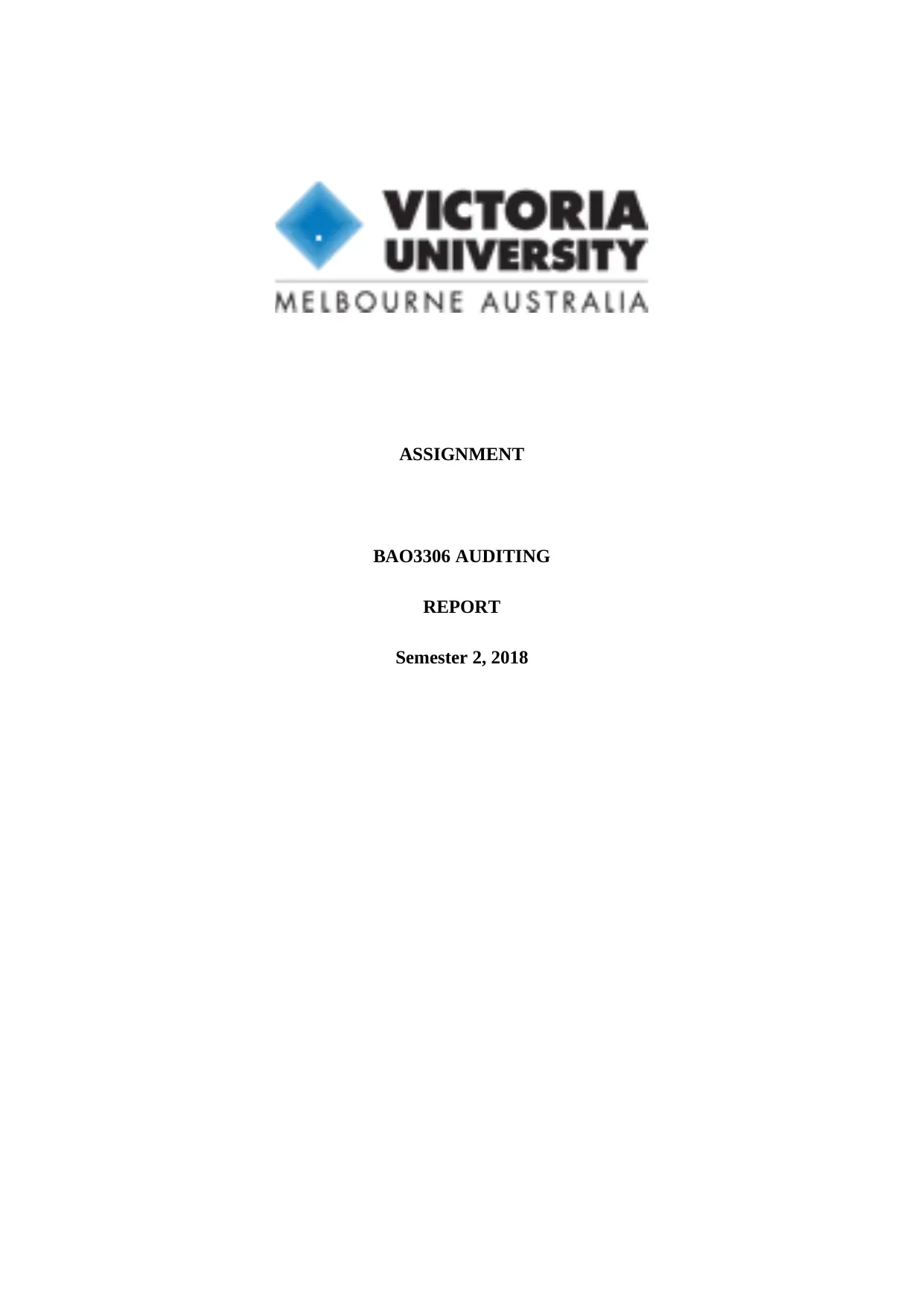
ASSIGNMENT
BAO3306 AUDITING
REPORT
Semester 2, 2018
BAO3306 AUDITING
REPORT
Semester 2, 2018
Paraphrase This Document
Need a fresh take? Get an instant paraphrase of this document with our AI Paraphraser
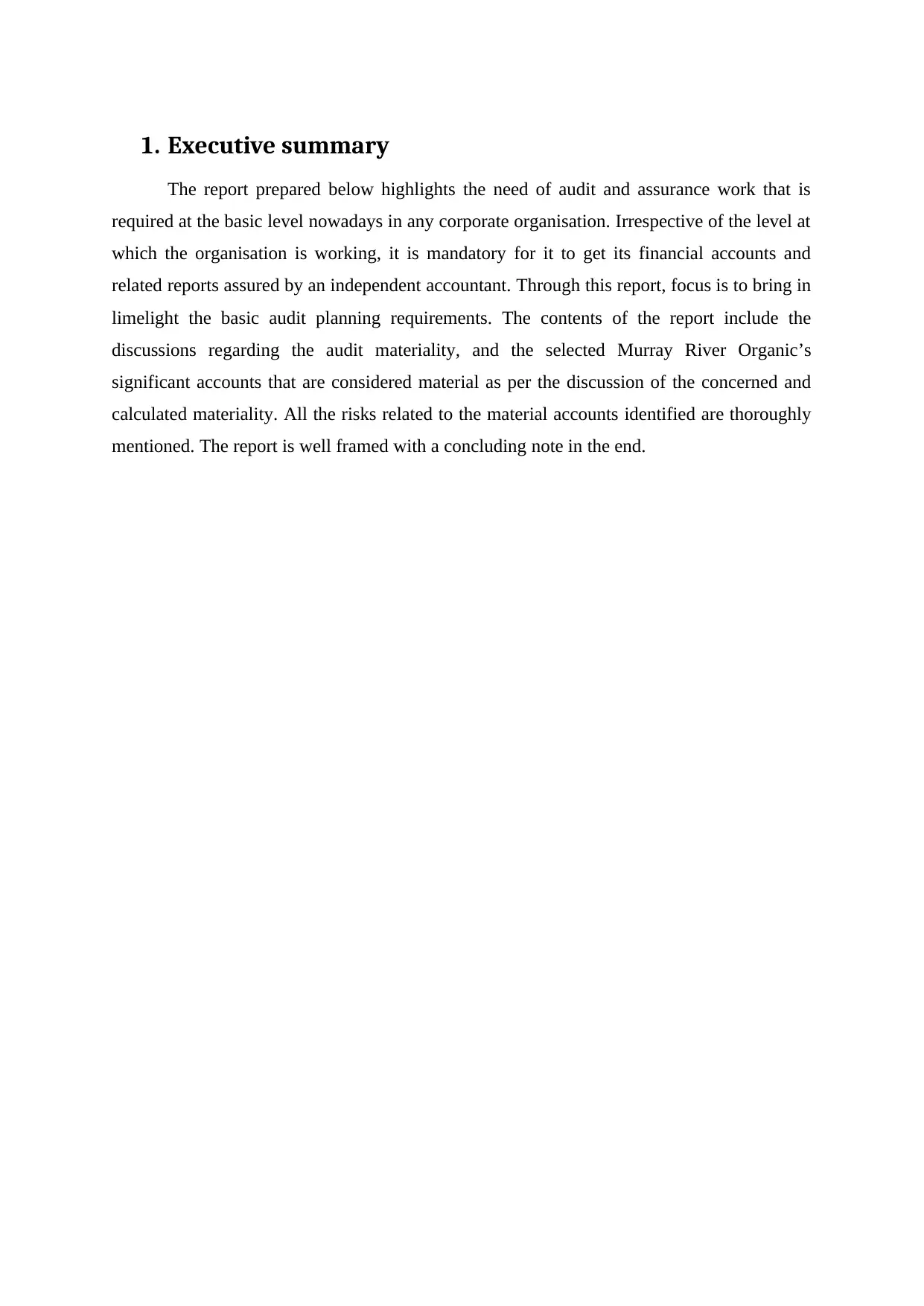
1. Executive summary
The report prepared below highlights the need of audit and assurance work that is
required at the basic level nowadays in any corporate organisation. Irrespective of the level at
which the organisation is working, it is mandatory for it to get its financial accounts and
related reports assured by an independent accountant. Through this report, focus is to bring in
limelight the basic audit planning requirements. The contents of the report include the
discussions regarding the audit materiality, and the selected Murray River Organic’s
significant accounts that are considered material as per the discussion of the concerned and
calculated materiality. All the risks related to the material accounts identified are thoroughly
mentioned. The report is well framed with a concluding note in the end.
The report prepared below highlights the need of audit and assurance work that is
required at the basic level nowadays in any corporate organisation. Irrespective of the level at
which the organisation is working, it is mandatory for it to get its financial accounts and
related reports assured by an independent accountant. Through this report, focus is to bring in
limelight the basic audit planning requirements. The contents of the report include the
discussions regarding the audit materiality, and the selected Murray River Organic’s
significant accounts that are considered material as per the discussion of the concerned and
calculated materiality. All the risks related to the material accounts identified are thoroughly
mentioned. The report is well framed with a concluding note in the end.
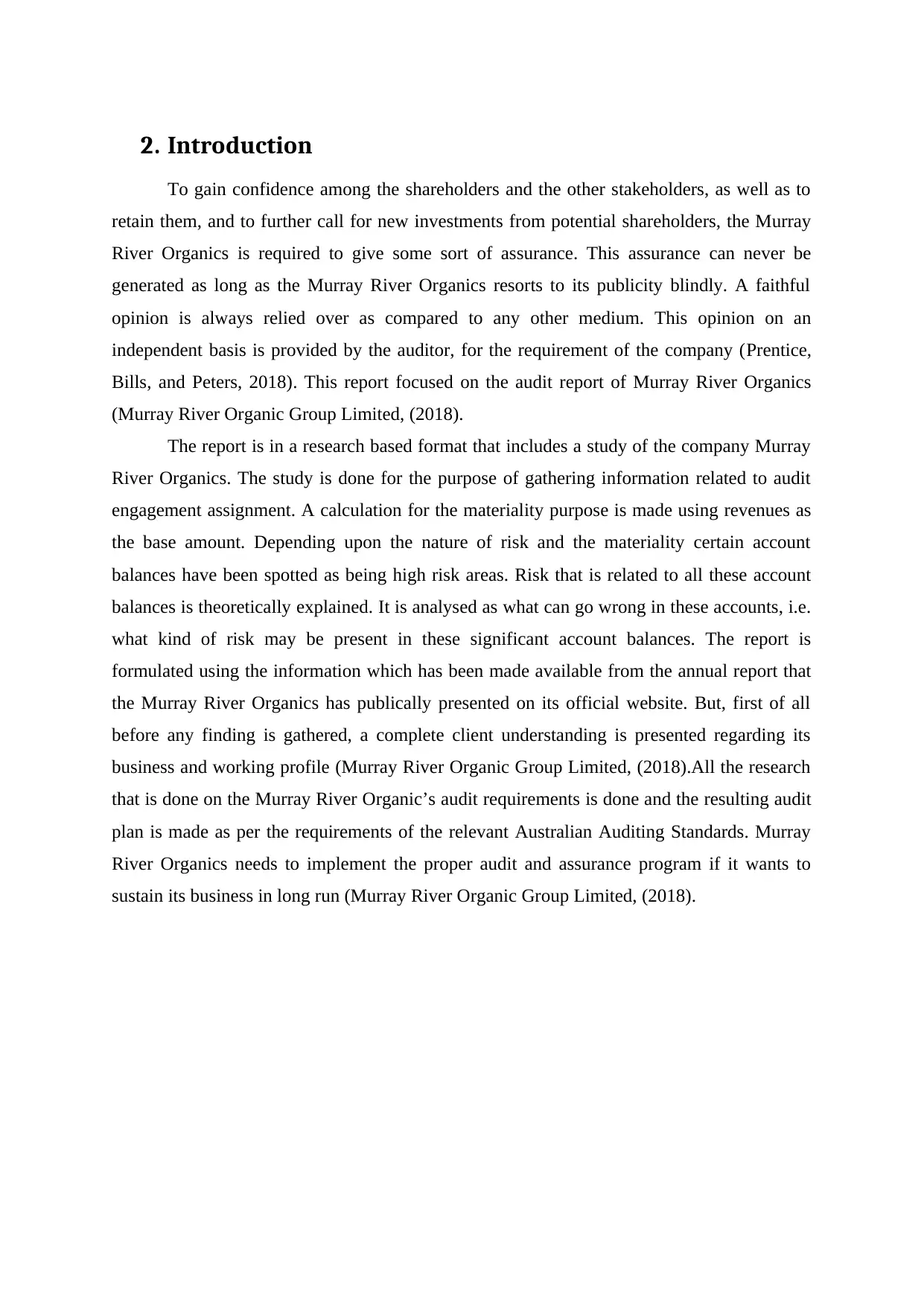
2. Introduction
To gain confidence among the shareholders and the other stakeholders, as well as to
retain them, and to further call for new investments from potential shareholders, the Murray
River Organics is required to give some sort of assurance. This assurance can never be
generated as long as the Murray River Organics resorts to its publicity blindly. A faithful
opinion is always relied over as compared to any other medium. This opinion on an
independent basis is provided by the auditor, for the requirement of the company (Prentice,
Bills, and Peters, 2018). This report focused on the audit report of Murray River Organics
(Murray River Organic Group Limited, (2018).
The report is in a research based format that includes a study of the company Murray
River Organics. The study is done for the purpose of gathering information related to audit
engagement assignment. A calculation for the materiality purpose is made using revenues as
the base amount. Depending upon the nature of risk and the materiality certain account
balances have been spotted as being high risk areas. Risk that is related to all these account
balances is theoretically explained. It is analysed as what can go wrong in these accounts, i.e.
what kind of risk may be present in these significant account balances. The report is
formulated using the information which has been made available from the annual report that
the Murray River Organics has publically presented on its official website. But, first of all
before any finding is gathered, a complete client understanding is presented regarding its
business and working profile (Murray River Organic Group Limited, (2018).All the research
that is done on the Murray River Organic’s audit requirements is done and the resulting audit
plan is made as per the requirements of the relevant Australian Auditing Standards. Murray
River Organics needs to implement the proper audit and assurance program if it wants to
sustain its business in long run (Murray River Organic Group Limited, (2018).
To gain confidence among the shareholders and the other stakeholders, as well as to
retain them, and to further call for new investments from potential shareholders, the Murray
River Organics is required to give some sort of assurance. This assurance can never be
generated as long as the Murray River Organics resorts to its publicity blindly. A faithful
opinion is always relied over as compared to any other medium. This opinion on an
independent basis is provided by the auditor, for the requirement of the company (Prentice,
Bills, and Peters, 2018). This report focused on the audit report of Murray River Organics
(Murray River Organic Group Limited, (2018).
The report is in a research based format that includes a study of the company Murray
River Organics. The study is done for the purpose of gathering information related to audit
engagement assignment. A calculation for the materiality purpose is made using revenues as
the base amount. Depending upon the nature of risk and the materiality certain account
balances have been spotted as being high risk areas. Risk that is related to all these account
balances is theoretically explained. It is analysed as what can go wrong in these accounts, i.e.
what kind of risk may be present in these significant account balances. The report is
formulated using the information which has been made available from the annual report that
the Murray River Organics has publically presented on its official website. But, first of all
before any finding is gathered, a complete client understanding is presented regarding its
business and working profile (Murray River Organic Group Limited, (2018).All the research
that is done on the Murray River Organic’s audit requirements is done and the resulting audit
plan is made as per the requirements of the relevant Australian Auditing Standards. Murray
River Organics needs to implement the proper audit and assurance program if it wants to
sustain its business in long run (Murray River Organic Group Limited, (2018).
⊘ This is a preview!⊘
Do you want full access?
Subscribe today to unlock all pages.

Trusted by 1+ million students worldwide
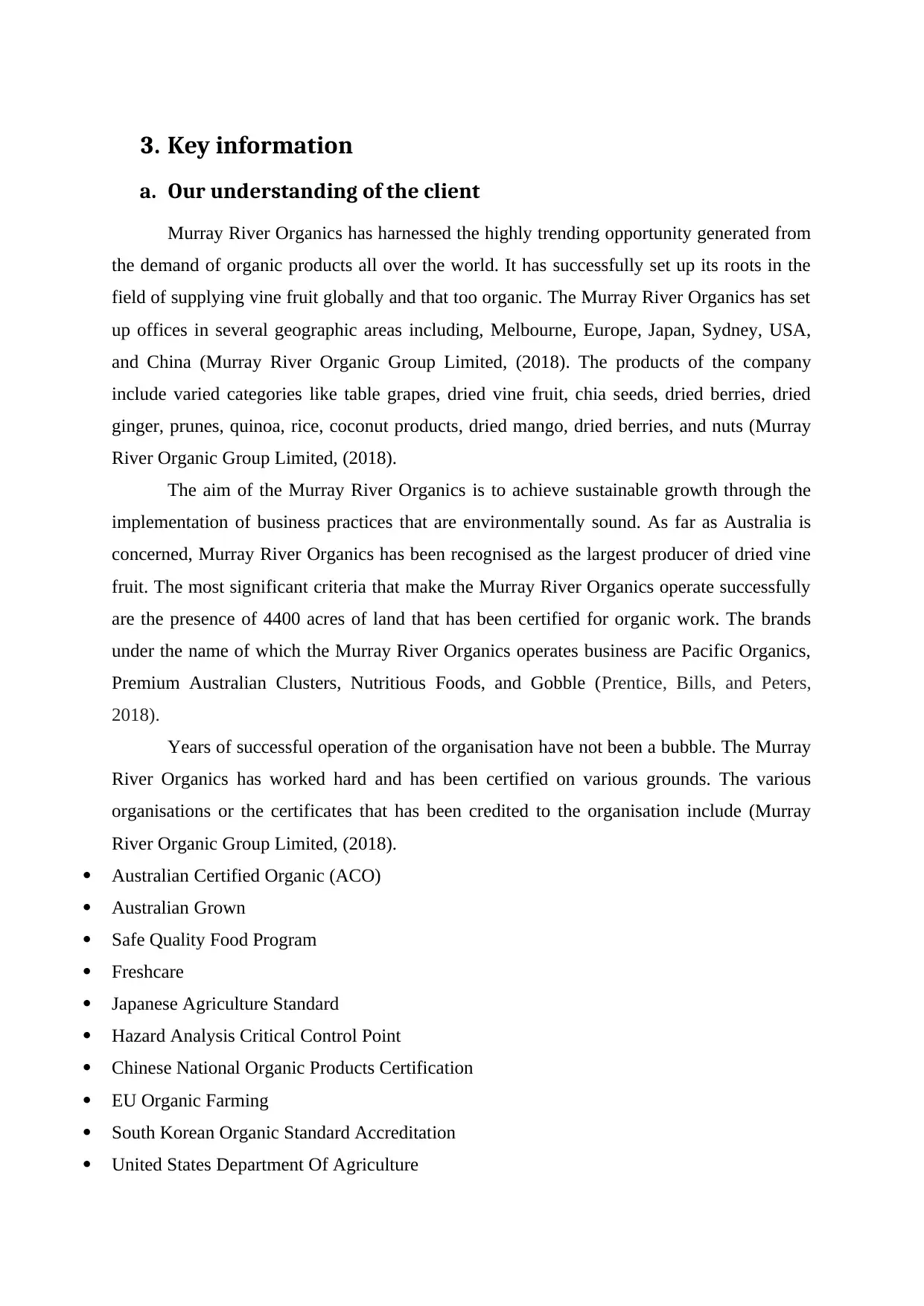
3. Key information
a. Our understanding of the client
Murray River Organics has harnessed the highly trending opportunity generated from
the demand of organic products all over the world. It has successfully set up its roots in the
field of supplying vine fruit globally and that too organic. The Murray River Organics has set
up offices in several geographic areas including, Melbourne, Europe, Japan, Sydney, USA,
and China (Murray River Organic Group Limited, (2018). The products of the company
include varied categories like table grapes, dried vine fruit, chia seeds, dried berries, dried
ginger, prunes, quinoa, rice, coconut products, dried mango, dried berries, and nuts (Murray
River Organic Group Limited, (2018).
The aim of the Murray River Organics is to achieve sustainable growth through the
implementation of business practices that are environmentally sound. As far as Australia is
concerned, Murray River Organics has been recognised as the largest producer of dried vine
fruit. The most significant criteria that make the Murray River Organics operate successfully
are the presence of 4400 acres of land that has been certified for organic work. The brands
under the name of which the Murray River Organics operates business are Pacific Organics,
Premium Australian Clusters, Nutritious Foods, and Gobble (Prentice, Bills, and Peters,
2018).
Years of successful operation of the organisation have not been a bubble. The Murray
River Organics has worked hard and has been certified on various grounds. The various
organisations or the certificates that has been credited to the organisation include (Murray
River Organic Group Limited, (2018).
Australian Certified Organic (ACO)
Australian Grown
Safe Quality Food Program
Freshcare
Japanese Agriculture Standard
Hazard Analysis Critical Control Point
Chinese National Organic Products Certification
EU Organic Farming
South Korean Organic Standard Accreditation
United States Department Of Agriculture
a. Our understanding of the client
Murray River Organics has harnessed the highly trending opportunity generated from
the demand of organic products all over the world. It has successfully set up its roots in the
field of supplying vine fruit globally and that too organic. The Murray River Organics has set
up offices in several geographic areas including, Melbourne, Europe, Japan, Sydney, USA,
and China (Murray River Organic Group Limited, (2018). The products of the company
include varied categories like table grapes, dried vine fruit, chia seeds, dried berries, dried
ginger, prunes, quinoa, rice, coconut products, dried mango, dried berries, and nuts (Murray
River Organic Group Limited, (2018).
The aim of the Murray River Organics is to achieve sustainable growth through the
implementation of business practices that are environmentally sound. As far as Australia is
concerned, Murray River Organics has been recognised as the largest producer of dried vine
fruit. The most significant criteria that make the Murray River Organics operate successfully
are the presence of 4400 acres of land that has been certified for organic work. The brands
under the name of which the Murray River Organics operates business are Pacific Organics,
Premium Australian Clusters, Nutritious Foods, and Gobble (Prentice, Bills, and Peters,
2018).
Years of successful operation of the organisation have not been a bubble. The Murray
River Organics has worked hard and has been certified on various grounds. The various
organisations or the certificates that has been credited to the organisation include (Murray
River Organic Group Limited, (2018).
Australian Certified Organic (ACO)
Australian Grown
Safe Quality Food Program
Freshcare
Japanese Agriculture Standard
Hazard Analysis Critical Control Point
Chinese National Organic Products Certification
EU Organic Farming
South Korean Organic Standard Accreditation
United States Department Of Agriculture
Paraphrase This Document
Need a fresh take? Get an instant paraphrase of this document with our AI Paraphraser
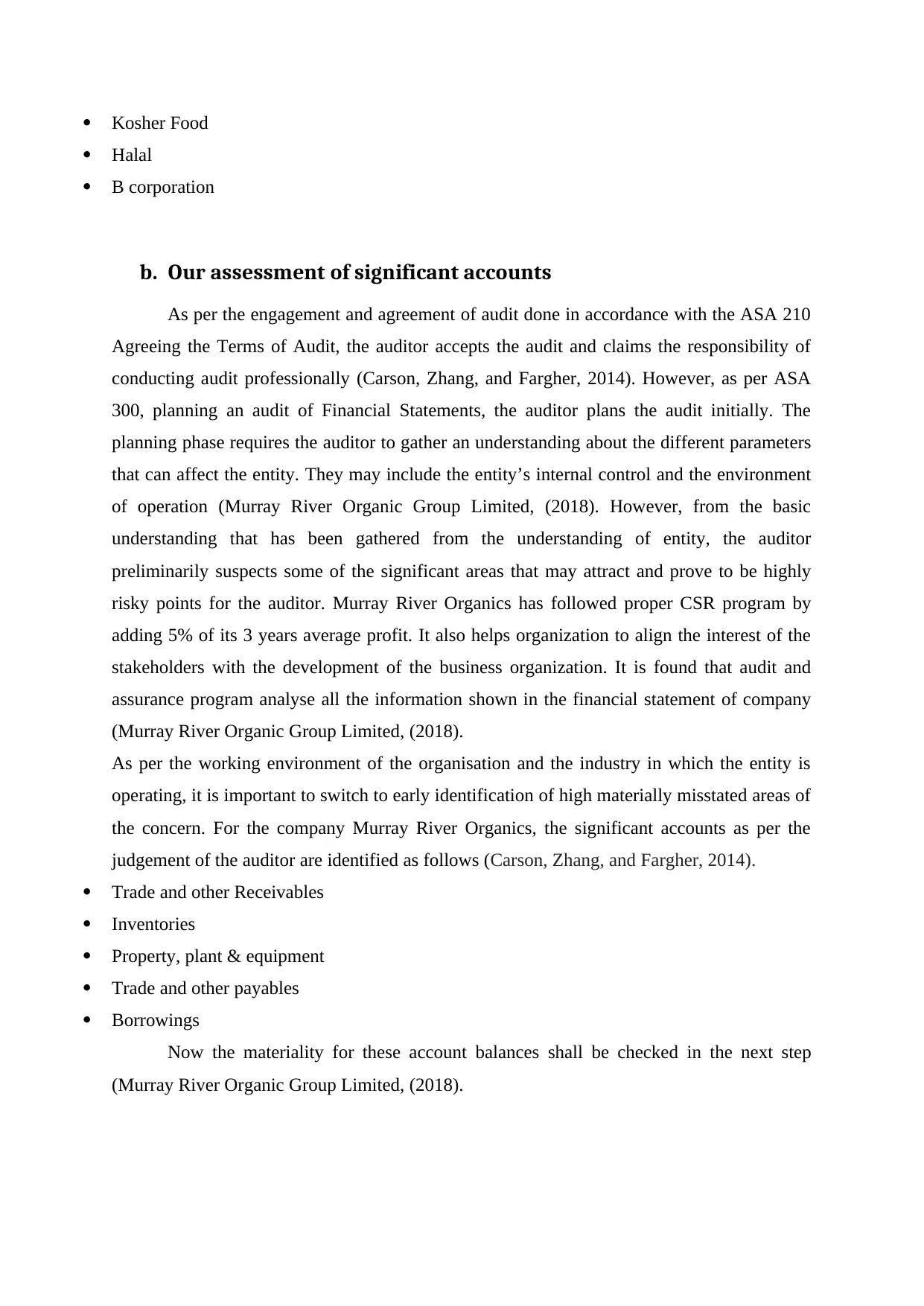
Kosher Food
Halal
B corporation
b. Our assessment of significant accounts
As per the engagement and agreement of audit done in accordance with the ASA 210
Agreeing the Terms of Audit, the auditor accepts the audit and claims the responsibility of
conducting audit professionally (Carson, Zhang, and Fargher, 2014). However, as per ASA
300, planning an audit of Financial Statements, the auditor plans the audit initially. The
planning phase requires the auditor to gather an understanding about the different parameters
that can affect the entity. They may include the entity’s internal control and the environment
of operation (Murray River Organic Group Limited, (2018). However, from the basic
understanding that has been gathered from the understanding of entity, the auditor
preliminarily suspects some of the significant areas that may attract and prove to be highly
risky points for the auditor. Murray River Organics has followed proper CSR program by
adding 5% of its 3 years average profit. It also helps organization to align the interest of the
stakeholders with the development of the business organization. It is found that audit and
assurance program analyse all the information shown in the financial statement of company
(Murray River Organic Group Limited, (2018).
As per the working environment of the organisation and the industry in which the entity is
operating, it is important to switch to early identification of high materially misstated areas of
the concern. For the company Murray River Organics, the significant accounts as per the
judgement of the auditor are identified as follows (Carson, Zhang, and Fargher, 2014).
Trade and other Receivables
Inventories
Property, plant & equipment
Trade and other payables
Borrowings
Now the materiality for these account balances shall be checked in the next step
(Murray River Organic Group Limited, (2018).
Halal
B corporation
b. Our assessment of significant accounts
As per the engagement and agreement of audit done in accordance with the ASA 210
Agreeing the Terms of Audit, the auditor accepts the audit and claims the responsibility of
conducting audit professionally (Carson, Zhang, and Fargher, 2014). However, as per ASA
300, planning an audit of Financial Statements, the auditor plans the audit initially. The
planning phase requires the auditor to gather an understanding about the different parameters
that can affect the entity. They may include the entity’s internal control and the environment
of operation (Murray River Organic Group Limited, (2018). However, from the basic
understanding that has been gathered from the understanding of entity, the auditor
preliminarily suspects some of the significant areas that may attract and prove to be highly
risky points for the auditor. Murray River Organics has followed proper CSR program by
adding 5% of its 3 years average profit. It also helps organization to align the interest of the
stakeholders with the development of the business organization. It is found that audit and
assurance program analyse all the information shown in the financial statement of company
(Murray River Organic Group Limited, (2018).
As per the working environment of the organisation and the industry in which the entity is
operating, it is important to switch to early identification of high materially misstated areas of
the concern. For the company Murray River Organics, the significant accounts as per the
judgement of the auditor are identified as follows (Carson, Zhang, and Fargher, 2014).
Trade and other Receivables
Inventories
Property, plant & equipment
Trade and other payables
Borrowings
Now the materiality for these account balances shall be checked in the next step
(Murray River Organic Group Limited, (2018).
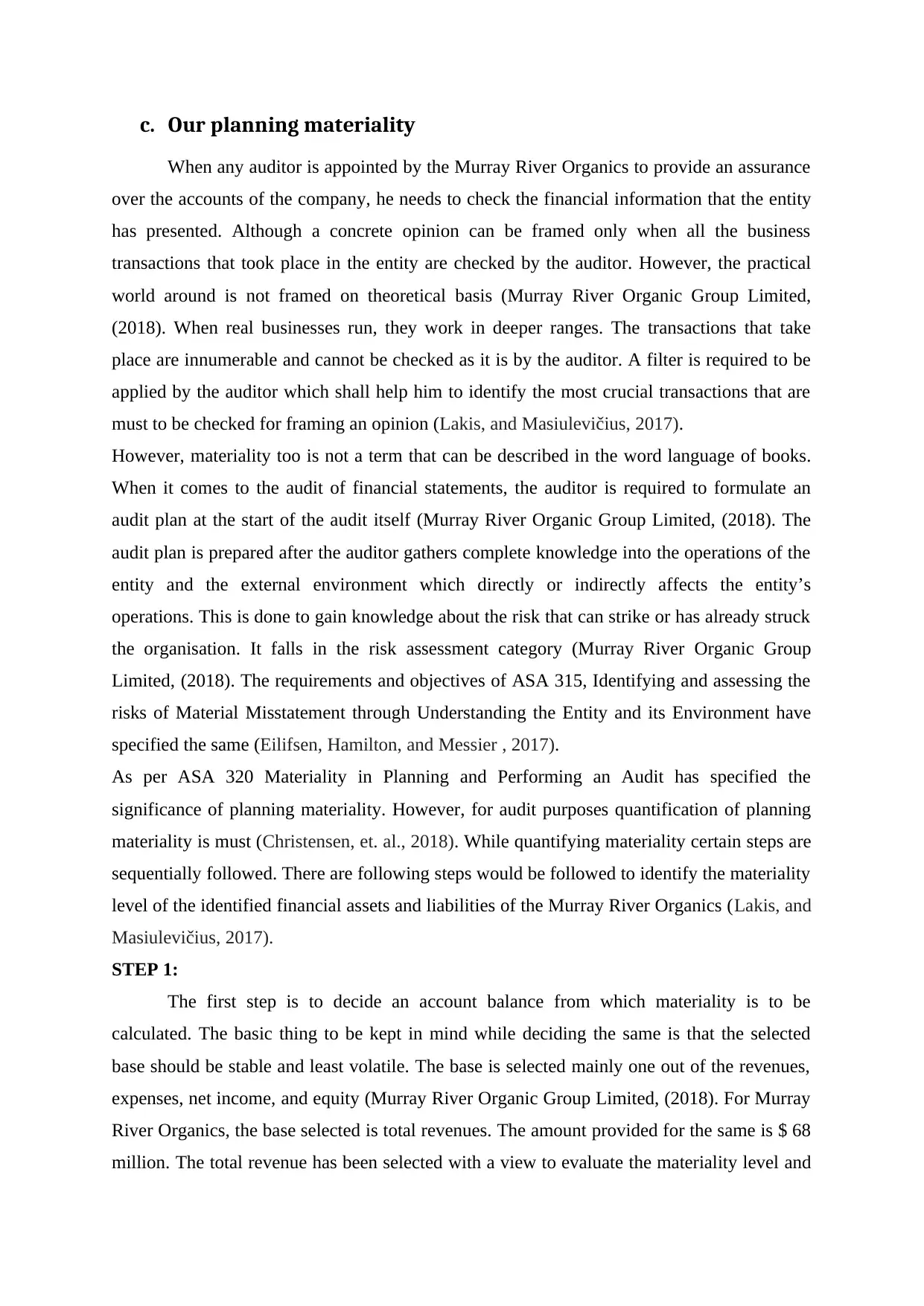
c. Our planning materiality
When any auditor is appointed by the Murray River Organics to provide an assurance
over the accounts of the company, he needs to check the financial information that the entity
has presented. Although a concrete opinion can be framed only when all the business
transactions that took place in the entity are checked by the auditor. However, the practical
world around is not framed on theoretical basis (Murray River Organic Group Limited,
(2018). When real businesses run, they work in deeper ranges. The transactions that take
place are innumerable and cannot be checked as it is by the auditor. A filter is required to be
applied by the auditor which shall help him to identify the most crucial transactions that are
must to be checked for framing an opinion (Lakis, and Masiulevičius, 2017).
However, materiality too is not a term that can be described in the word language of books.
When it comes to the audit of financial statements, the auditor is required to formulate an
audit plan at the start of the audit itself (Murray River Organic Group Limited, (2018). The
audit plan is prepared after the auditor gathers complete knowledge into the operations of the
entity and the external environment which directly or indirectly affects the entity’s
operations. This is done to gain knowledge about the risk that can strike or has already struck
the organisation. It falls in the risk assessment category (Murray River Organic Group
Limited, (2018). The requirements and objectives of ASA 315, Identifying and assessing the
risks of Material Misstatement through Understanding the Entity and its Environment have
specified the same (Eilifsen, Hamilton, and Messier , 2017).
As per ASA 320 Materiality in Planning and Performing an Audit has specified the
significance of planning materiality. However, for audit purposes quantification of planning
materiality is must (Christensen, et. al., 2018). While quantifying materiality certain steps are
sequentially followed. There are following steps would be followed to identify the materiality
level of the identified financial assets and liabilities of the Murray River Organics (Lakis, and
Masiulevičius, 2017).
STEP 1:
The first step is to decide an account balance from which materiality is to be
calculated. The basic thing to be kept in mind while deciding the same is that the selected
base should be stable and least volatile. The base is selected mainly one out of the revenues,
expenses, net income, and equity (Murray River Organic Group Limited, (2018). For Murray
River Organics, the base selected is total revenues. The amount provided for the same is $ 68
million. The total revenue has been selected with a view to evaluate the materiality level and
When any auditor is appointed by the Murray River Organics to provide an assurance
over the accounts of the company, he needs to check the financial information that the entity
has presented. Although a concrete opinion can be framed only when all the business
transactions that took place in the entity are checked by the auditor. However, the practical
world around is not framed on theoretical basis (Murray River Organic Group Limited,
(2018). When real businesses run, they work in deeper ranges. The transactions that take
place are innumerable and cannot be checked as it is by the auditor. A filter is required to be
applied by the auditor which shall help him to identify the most crucial transactions that are
must to be checked for framing an opinion (Lakis, and Masiulevičius, 2017).
However, materiality too is not a term that can be described in the word language of books.
When it comes to the audit of financial statements, the auditor is required to formulate an
audit plan at the start of the audit itself (Murray River Organic Group Limited, (2018). The
audit plan is prepared after the auditor gathers complete knowledge into the operations of the
entity and the external environment which directly or indirectly affects the entity’s
operations. This is done to gain knowledge about the risk that can strike or has already struck
the organisation. It falls in the risk assessment category (Murray River Organic Group
Limited, (2018). The requirements and objectives of ASA 315, Identifying and assessing the
risks of Material Misstatement through Understanding the Entity and its Environment have
specified the same (Eilifsen, Hamilton, and Messier , 2017).
As per ASA 320 Materiality in Planning and Performing an Audit has specified the
significance of planning materiality. However, for audit purposes quantification of planning
materiality is must (Christensen, et. al., 2018). While quantifying materiality certain steps are
sequentially followed. There are following steps would be followed to identify the materiality
level of the identified financial assets and liabilities of the Murray River Organics (Lakis, and
Masiulevičius, 2017).
STEP 1:
The first step is to decide an account balance from which materiality is to be
calculated. The basic thing to be kept in mind while deciding the same is that the selected
base should be stable and least volatile. The base is selected mainly one out of the revenues,
expenses, net income, and equity (Murray River Organic Group Limited, (2018). For Murray
River Organics, the base selected is total revenues. The amount provided for the same is $ 68
million. The total revenue has been selected with a view to evaluate the materiality level and
⊘ This is a preview!⊘
Do you want full access?
Subscribe today to unlock all pages.

Trusted by 1+ million students worldwide
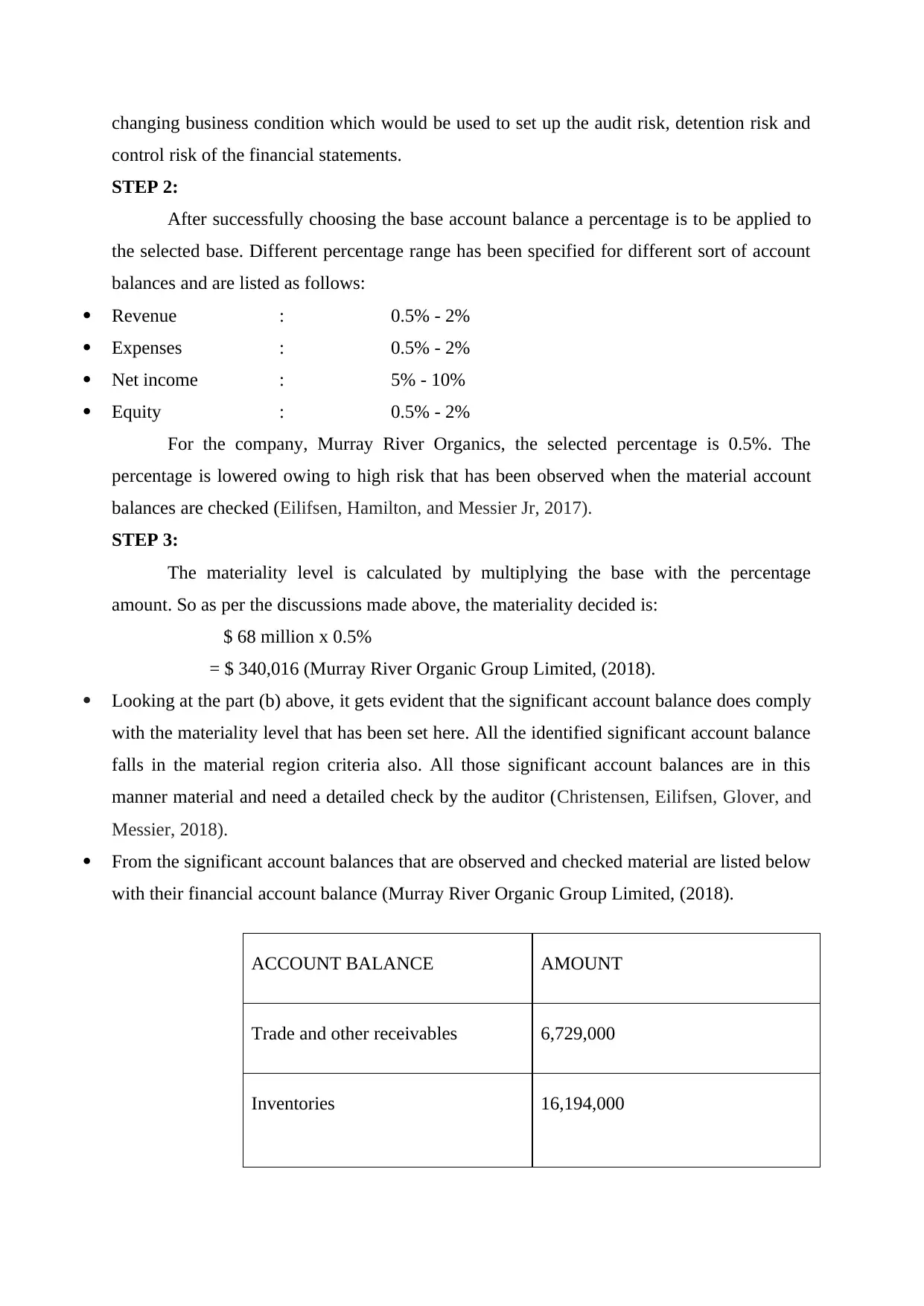
changing business condition which would be used to set up the audit risk, detention risk and
control risk of the financial statements.
STEP 2:
After successfully choosing the base account balance a percentage is to be applied to
the selected base. Different percentage range has been specified for different sort of account
balances and are listed as follows:
Revenue : 0.5% - 2%
Expenses : 0.5% - 2%
Net income : 5% - 10%
Equity : 0.5% - 2%
For the company, Murray River Organics, the selected percentage is 0.5%. The
percentage is lowered owing to high risk that has been observed when the material account
balances are checked (Eilifsen, Hamilton, and Messier Jr, 2017).
STEP 3:
The materiality level is calculated by multiplying the base with the percentage
amount. So as per the discussions made above, the materiality decided is:
$ 68 million x 0.5%
= $ 340,016 (Murray River Organic Group Limited, (2018).
Looking at the part (b) above, it gets evident that the significant account balance does comply
with the materiality level that has been set here. All the identified significant account balance
falls in the material region criteria also. All those significant account balances are in this
manner material and need a detailed check by the auditor (Christensen, Eilifsen, Glover, and
Messier, 2018).
From the significant account balances that are observed and checked material are listed below
with their financial account balance (Murray River Organic Group Limited, (2018).
ACCOUNT BALANCE AMOUNT
Trade and other receivables 6,729,000
Inventories 16,194,000
control risk of the financial statements.
STEP 2:
After successfully choosing the base account balance a percentage is to be applied to
the selected base. Different percentage range has been specified for different sort of account
balances and are listed as follows:
Revenue : 0.5% - 2%
Expenses : 0.5% - 2%
Net income : 5% - 10%
Equity : 0.5% - 2%
For the company, Murray River Organics, the selected percentage is 0.5%. The
percentage is lowered owing to high risk that has been observed when the material account
balances are checked (Eilifsen, Hamilton, and Messier Jr, 2017).
STEP 3:
The materiality level is calculated by multiplying the base with the percentage
amount. So as per the discussions made above, the materiality decided is:
$ 68 million x 0.5%
= $ 340,016 (Murray River Organic Group Limited, (2018).
Looking at the part (b) above, it gets evident that the significant account balance does comply
with the materiality level that has been set here. All the identified significant account balance
falls in the material region criteria also. All those significant account balances are in this
manner material and need a detailed check by the auditor (Christensen, Eilifsen, Glover, and
Messier, 2018).
From the significant account balances that are observed and checked material are listed below
with their financial account balance (Murray River Organic Group Limited, (2018).
ACCOUNT BALANCE AMOUNT
Trade and other receivables 6,729,000
Inventories 16,194,000
Paraphrase This Document
Need a fresh take? Get an instant paraphrase of this document with our AI Paraphraser
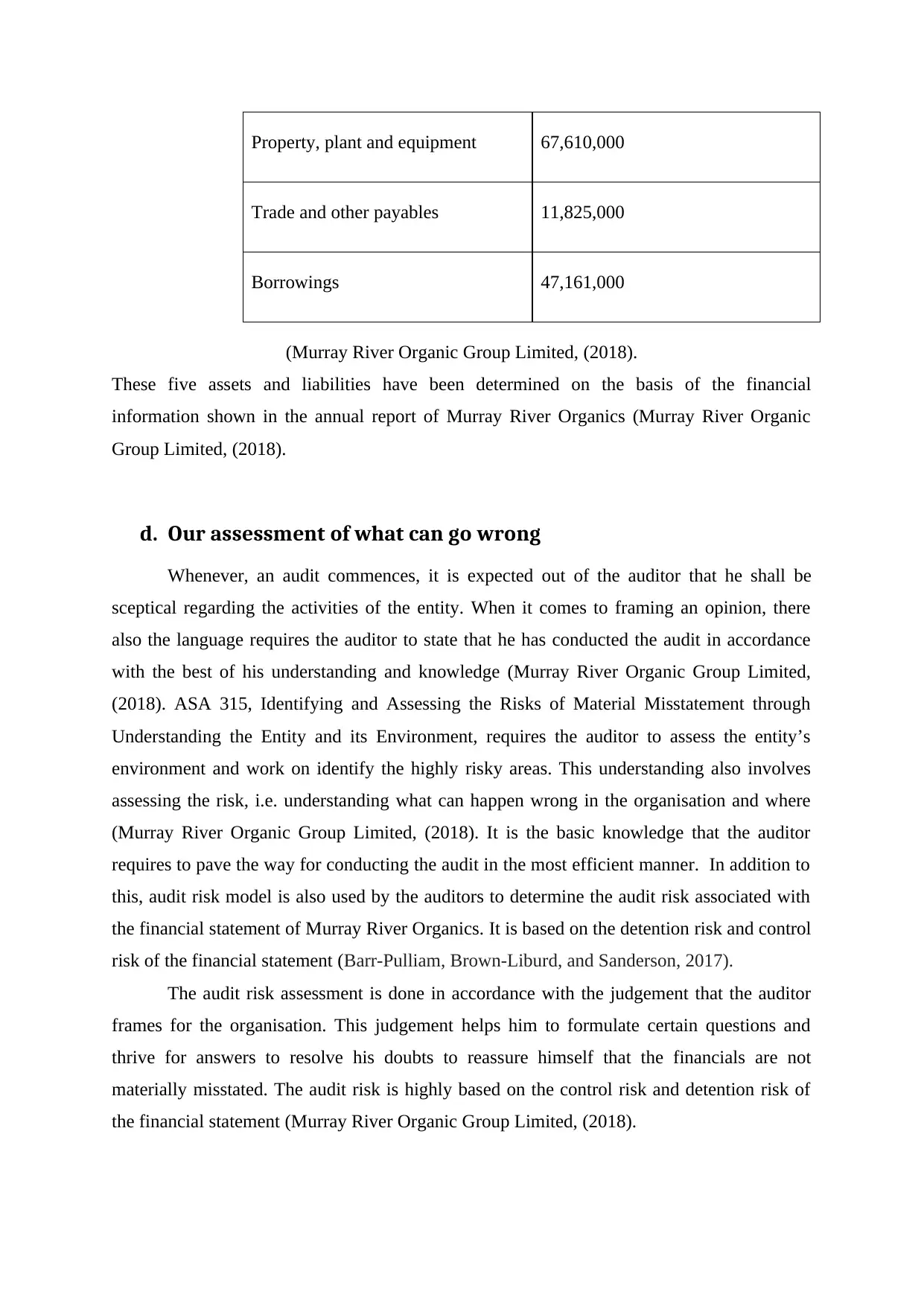
Property, plant and equipment 67,610,000
Trade and other payables 11,825,000
Borrowings 47,161,000
(Murray River Organic Group Limited, (2018).
These five assets and liabilities have been determined on the basis of the financial
information shown in the annual report of Murray River Organics (Murray River Organic
Group Limited, (2018).
d. Our assessment of what can go wrong
Whenever, an audit commences, it is expected out of the auditor that he shall be
sceptical regarding the activities of the entity. When it comes to framing an opinion, there
also the language requires the auditor to state that he has conducted the audit in accordance
with the best of his understanding and knowledge (Murray River Organic Group Limited,
(2018). ASA 315, Identifying and Assessing the Risks of Material Misstatement through
Understanding the Entity and its Environment, requires the auditor to assess the entity’s
environment and work on identify the highly risky areas. This understanding also involves
assessing the risk, i.e. understanding what can happen wrong in the organisation and where
(Murray River Organic Group Limited, (2018). It is the basic knowledge that the auditor
requires to pave the way for conducting the audit in the most efficient manner. In addition to
this, audit risk model is also used by the auditors to determine the audit risk associated with
the financial statement of Murray River Organics. It is based on the detention risk and control
risk of the financial statement (Barr-Pulliam, Brown-Liburd, and Sanderson, 2017).
The audit risk assessment is done in accordance with the judgement that the auditor
frames for the organisation. This judgement helps him to formulate certain questions and
thrive for answers to resolve his doubts to reassure himself that the financials are not
materially misstated. The audit risk is highly based on the control risk and detention risk of
the financial statement (Murray River Organic Group Limited, (2018).
Trade and other payables 11,825,000
Borrowings 47,161,000
(Murray River Organic Group Limited, (2018).
These five assets and liabilities have been determined on the basis of the financial
information shown in the annual report of Murray River Organics (Murray River Organic
Group Limited, (2018).
d. Our assessment of what can go wrong
Whenever, an audit commences, it is expected out of the auditor that he shall be
sceptical regarding the activities of the entity. When it comes to framing an opinion, there
also the language requires the auditor to state that he has conducted the audit in accordance
with the best of his understanding and knowledge (Murray River Organic Group Limited,
(2018). ASA 315, Identifying and Assessing the Risks of Material Misstatement through
Understanding the Entity and its Environment, requires the auditor to assess the entity’s
environment and work on identify the highly risky areas. This understanding also involves
assessing the risk, i.e. understanding what can happen wrong in the organisation and where
(Murray River Organic Group Limited, (2018). It is the basic knowledge that the auditor
requires to pave the way for conducting the audit in the most efficient manner. In addition to
this, audit risk model is also used by the auditors to determine the audit risk associated with
the financial statement of Murray River Organics. It is based on the detention risk and control
risk of the financial statement (Barr-Pulliam, Brown-Liburd, and Sanderson, 2017).
The audit risk assessment is done in accordance with the judgement that the auditor
frames for the organisation. This judgement helps him to formulate certain questions and
thrive for answers to resolve his doubts to reassure himself that the financials are not
materially misstated. The audit risk is highly based on the control risk and detention risk of
the financial statement (Murray River Organic Group Limited, (2018).
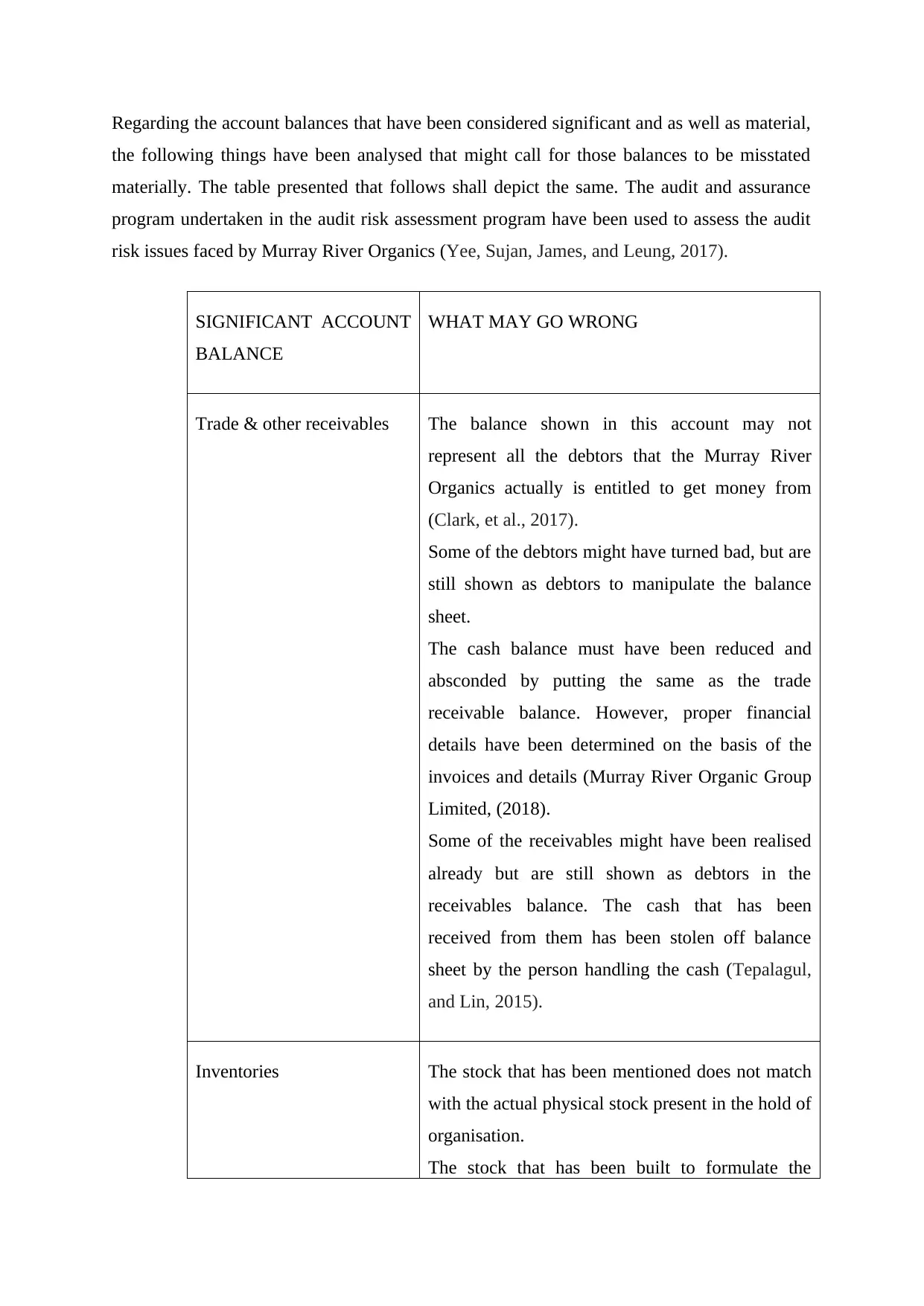
Regarding the account balances that have been considered significant and as well as material,
the following things have been analysed that might call for those balances to be misstated
materially. The table presented that follows shall depict the same. The audit and assurance
program undertaken in the audit risk assessment program have been used to assess the audit
risk issues faced by Murray River Organics (Yee, Sujan, James, and Leung, 2017).
SIGNIFICANT ACCOUNT
BALANCE
WHAT MAY GO WRONG
Trade & other receivables The balance shown in this account may not
represent all the debtors that the Murray River
Organics actually is entitled to get money from
(Clark, et al., 2017).
Some of the debtors might have turned bad, but are
still shown as debtors to manipulate the balance
sheet.
The cash balance must have been reduced and
absconded by putting the same as the trade
receivable balance. However, proper financial
details have been determined on the basis of the
invoices and details (Murray River Organic Group
Limited, (2018).
Some of the receivables might have been realised
already but are still shown as debtors in the
receivables balance. The cash that has been
received from them has been stolen off balance
sheet by the person handling the cash (Tepalagul,
and Lin, 2015).
Inventories The stock that has been mentioned does not match
with the actual physical stock present in the hold of
organisation.
The stock that has been built to formulate the
the following things have been analysed that might call for those balances to be misstated
materially. The table presented that follows shall depict the same. The audit and assurance
program undertaken in the audit risk assessment program have been used to assess the audit
risk issues faced by Murray River Organics (Yee, Sujan, James, and Leung, 2017).
SIGNIFICANT ACCOUNT
BALANCE
WHAT MAY GO WRONG
Trade & other receivables The balance shown in this account may not
represent all the debtors that the Murray River
Organics actually is entitled to get money from
(Clark, et al., 2017).
Some of the debtors might have turned bad, but are
still shown as debtors to manipulate the balance
sheet.
The cash balance must have been reduced and
absconded by putting the same as the trade
receivable balance. However, proper financial
details have been determined on the basis of the
invoices and details (Murray River Organic Group
Limited, (2018).
Some of the receivables might have been realised
already but are still shown as debtors in the
receivables balance. The cash that has been
received from them has been stolen off balance
sheet by the person handling the cash (Tepalagul,
and Lin, 2015).
Inventories The stock that has been mentioned does not match
with the actual physical stock present in the hold of
organisation.
The stock that has been built to formulate the
⊘ This is a preview!⊘
Do you want full access?
Subscribe today to unlock all pages.

Trusted by 1+ million students worldwide
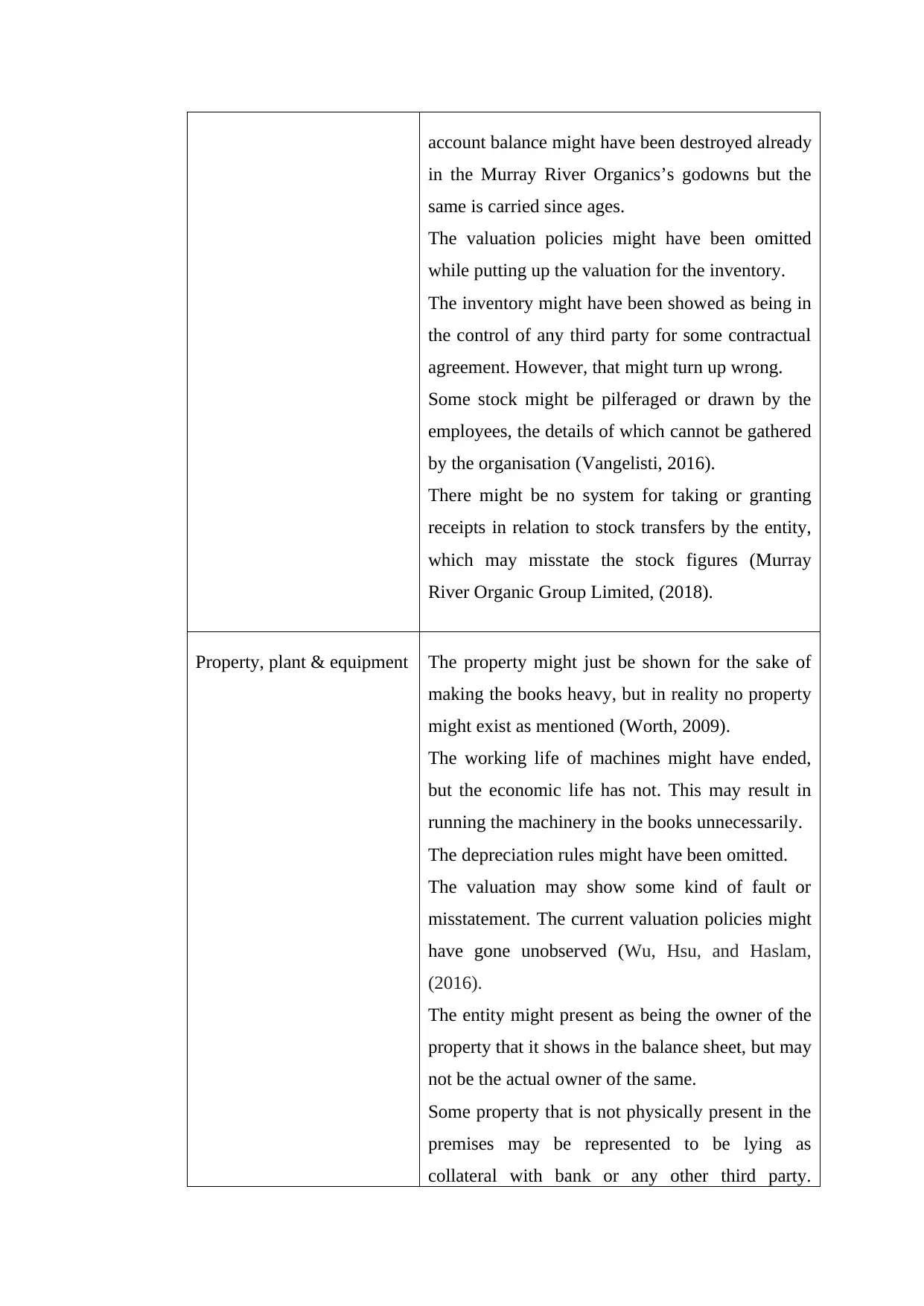
account balance might have been destroyed already
in the Murray River Organics’s godowns but the
same is carried since ages.
The valuation policies might have been omitted
while putting up the valuation for the inventory.
The inventory might have been showed as being in
the control of any third party for some contractual
agreement. However, that might turn up wrong.
Some stock might be pilferaged or drawn by the
employees, the details of which cannot be gathered
by the organisation (Vangelisti, 2016).
There might be no system for taking or granting
receipts in relation to stock transfers by the entity,
which may misstate the stock figures (Murray
River Organic Group Limited, (2018).
Property, plant & equipment The property might just be shown for the sake of
making the books heavy, but in reality no property
might exist as mentioned (Worth, 2009).
The working life of machines might have ended,
but the economic life has not. This may result in
running the machinery in the books unnecessarily.
The depreciation rules might have been omitted.
The valuation may show some kind of fault or
misstatement. The current valuation policies might
have gone unobserved (Wu, Hsu, and Haslam,
(2016).
The entity might present as being the owner of the
property that it shows in the balance sheet, but may
not be the actual owner of the same.
Some property that is not physically present in the
premises may be represented to be lying as
collateral with bank or any other third party.
in the Murray River Organics’s godowns but the
same is carried since ages.
The valuation policies might have been omitted
while putting up the valuation for the inventory.
The inventory might have been showed as being in
the control of any third party for some contractual
agreement. However, that might turn up wrong.
Some stock might be pilferaged or drawn by the
employees, the details of which cannot be gathered
by the organisation (Vangelisti, 2016).
There might be no system for taking or granting
receipts in relation to stock transfers by the entity,
which may misstate the stock figures (Murray
River Organic Group Limited, (2018).
Property, plant & equipment The property might just be shown for the sake of
making the books heavy, but in reality no property
might exist as mentioned (Worth, 2009).
The working life of machines might have ended,
but the economic life has not. This may result in
running the machinery in the books unnecessarily.
The depreciation rules might have been omitted.
The valuation may show some kind of fault or
misstatement. The current valuation policies might
have gone unobserved (Wu, Hsu, and Haslam,
(2016).
The entity might present as being the owner of the
property that it shows in the balance sheet, but may
not be the actual owner of the same.
Some property that is not physically present in the
premises may be represented to be lying as
collateral with bank or any other third party.
Paraphrase This Document
Need a fresh take? Get an instant paraphrase of this document with our AI Paraphraser
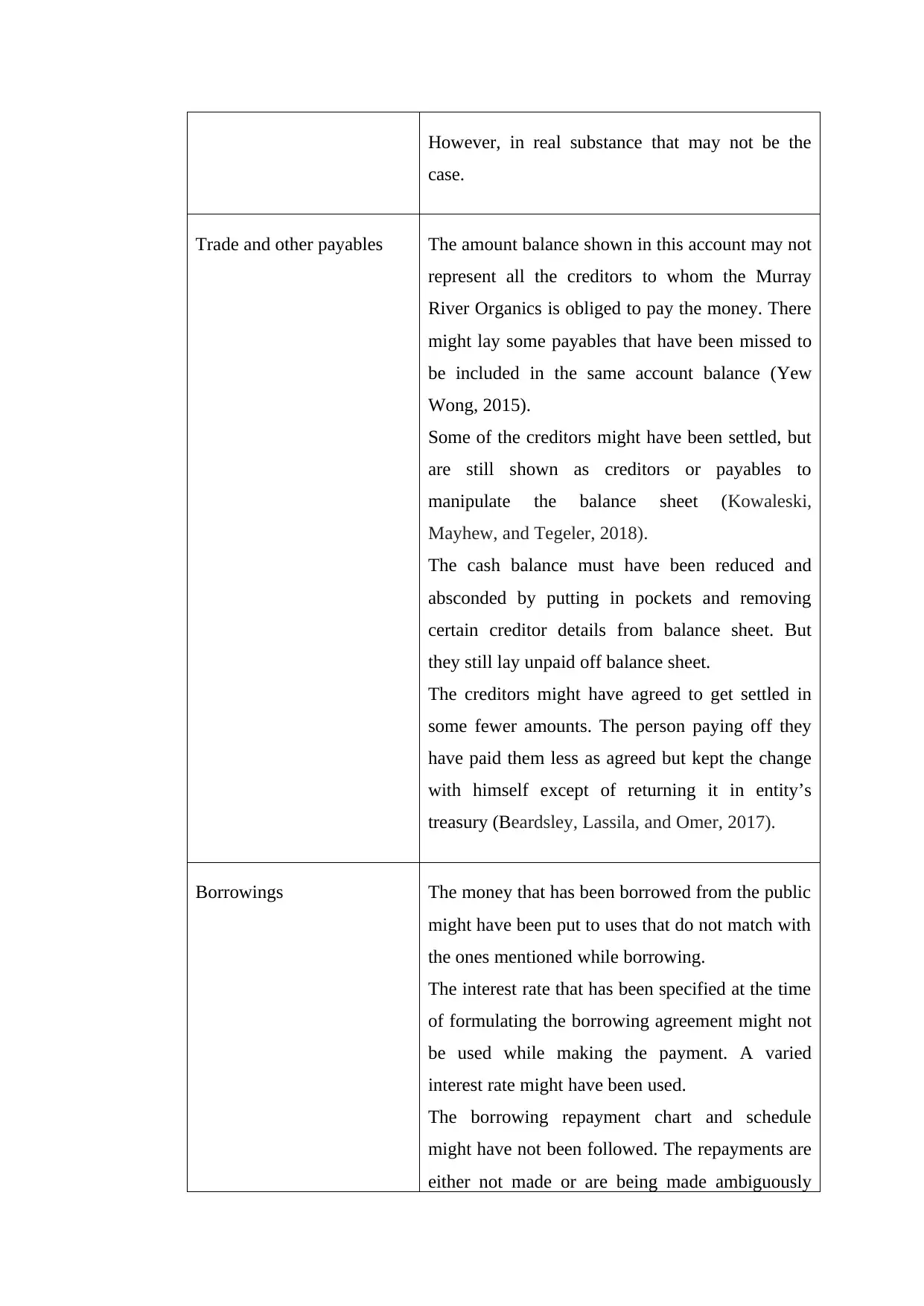
However, in real substance that may not be the
case.
Trade and other payables The amount balance shown in this account may not
represent all the creditors to whom the Murray
River Organics is obliged to pay the money. There
might lay some payables that have been missed to
be included in the same account balance (Yew
Wong, 2015).
Some of the creditors might have been settled, but
are still shown as creditors or payables to
manipulate the balance sheet (Kowaleski,
Mayhew, and Tegeler, 2018).
The cash balance must have been reduced and
absconded by putting in pockets and removing
certain creditor details from balance sheet. But
they still lay unpaid off balance sheet.
The creditors might have agreed to get settled in
some fewer amounts. The person paying off they
have paid them less as agreed but kept the change
with himself except of returning it in entity’s
treasury (Beardsley, Lassila, and Omer, 2017).
Borrowings The money that has been borrowed from the public
might have been put to uses that do not match with
the ones mentioned while borrowing.
The interest rate that has been specified at the time
of formulating the borrowing agreement might not
be used while making the payment. A varied
interest rate might have been used.
The borrowing repayment chart and schedule
might have not been followed. The repayments are
either not made or are being made ambiguously
case.
Trade and other payables The amount balance shown in this account may not
represent all the creditors to whom the Murray
River Organics is obliged to pay the money. There
might lay some payables that have been missed to
be included in the same account balance (Yew
Wong, 2015).
Some of the creditors might have been settled, but
are still shown as creditors or payables to
manipulate the balance sheet (Kowaleski,
Mayhew, and Tegeler, 2018).
The cash balance must have been reduced and
absconded by putting in pockets and removing
certain creditor details from balance sheet. But
they still lay unpaid off balance sheet.
The creditors might have agreed to get settled in
some fewer amounts. The person paying off they
have paid them less as agreed but kept the change
with himself except of returning it in entity’s
treasury (Beardsley, Lassila, and Omer, 2017).
Borrowings The money that has been borrowed from the public
might have been put to uses that do not match with
the ones mentioned while borrowing.
The interest rate that has been specified at the time
of formulating the borrowing agreement might not
be used while making the payment. A varied
interest rate might have been used.
The borrowing repayment chart and schedule
might have not been followed. The repayments are
either not made or are being made ambiguously
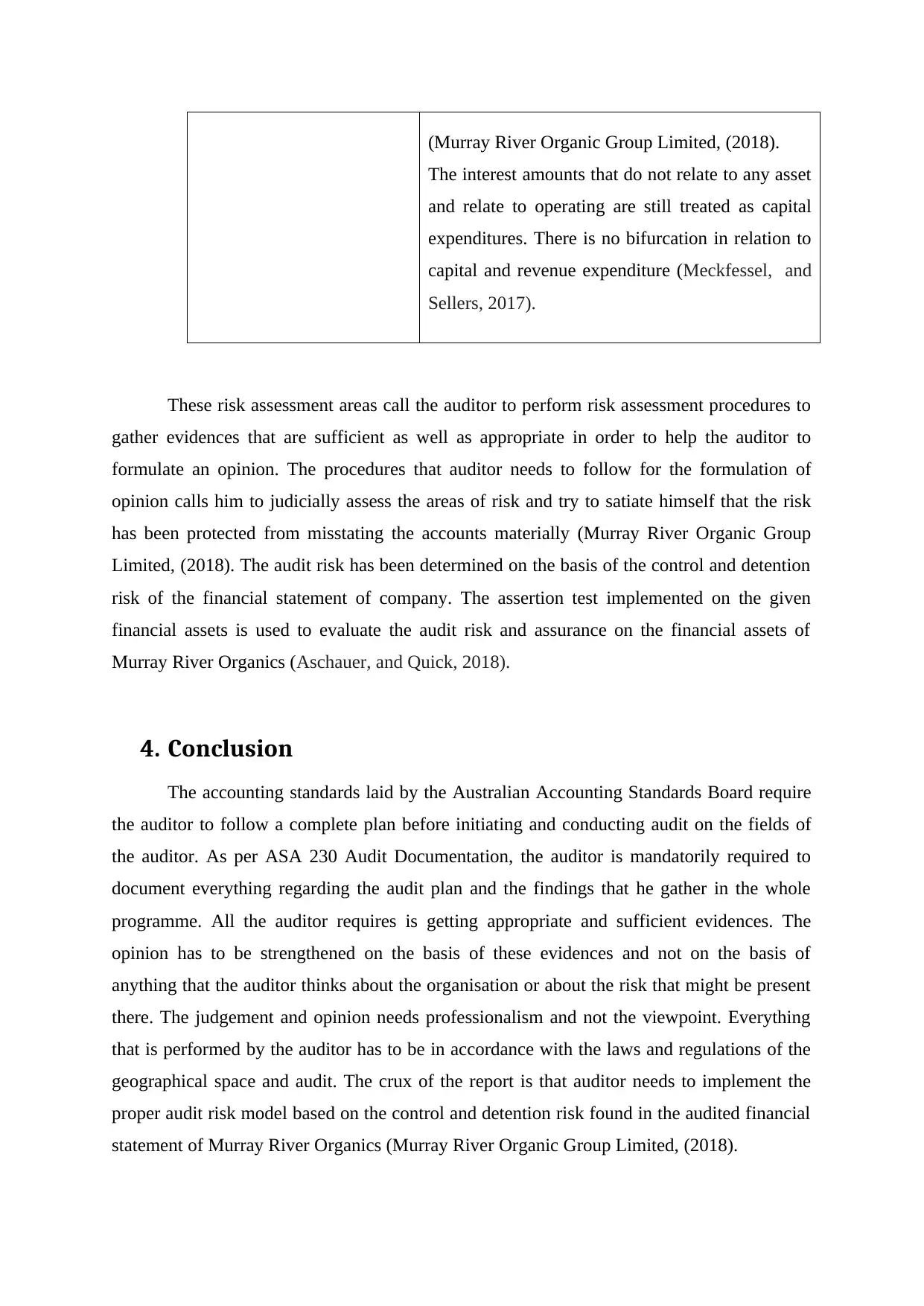
(Murray River Organic Group Limited, (2018).
The interest amounts that do not relate to any asset
and relate to operating are still treated as capital
expenditures. There is no bifurcation in relation to
capital and revenue expenditure (Meckfessel, and
Sellers, 2017).
These risk assessment areas call the auditor to perform risk assessment procedures to
gather evidences that are sufficient as well as appropriate in order to help the auditor to
formulate an opinion. The procedures that auditor needs to follow for the formulation of
opinion calls him to judicially assess the areas of risk and try to satiate himself that the risk
has been protected from misstating the accounts materially (Murray River Organic Group
Limited, (2018). The audit risk has been determined on the basis of the control and detention
risk of the financial statement of company. The assertion test implemented on the given
financial assets is used to evaluate the audit risk and assurance on the financial assets of
Murray River Organics (Aschauer, and Quick, 2018).
4. Conclusion
The accounting standards laid by the Australian Accounting Standards Board require
the auditor to follow a complete plan before initiating and conducting audit on the fields of
the auditor. As per ASA 230 Audit Documentation, the auditor is mandatorily required to
document everything regarding the audit plan and the findings that he gather in the whole
programme. All the auditor requires is getting appropriate and sufficient evidences. The
opinion has to be strengthened on the basis of these evidences and not on the basis of
anything that the auditor thinks about the organisation or about the risk that might be present
there. The judgement and opinion needs professionalism and not the viewpoint. Everything
that is performed by the auditor has to be in accordance with the laws and regulations of the
geographical space and audit. The crux of the report is that auditor needs to implement the
proper audit risk model based on the control and detention risk found in the audited financial
statement of Murray River Organics (Murray River Organic Group Limited, (2018).
The interest amounts that do not relate to any asset
and relate to operating are still treated as capital
expenditures. There is no bifurcation in relation to
capital and revenue expenditure (Meckfessel, and
Sellers, 2017).
These risk assessment areas call the auditor to perform risk assessment procedures to
gather evidences that are sufficient as well as appropriate in order to help the auditor to
formulate an opinion. The procedures that auditor needs to follow for the formulation of
opinion calls him to judicially assess the areas of risk and try to satiate himself that the risk
has been protected from misstating the accounts materially (Murray River Organic Group
Limited, (2018). The audit risk has been determined on the basis of the control and detention
risk of the financial statement of company. The assertion test implemented on the given
financial assets is used to evaluate the audit risk and assurance on the financial assets of
Murray River Organics (Aschauer, and Quick, 2018).
4. Conclusion
The accounting standards laid by the Australian Accounting Standards Board require
the auditor to follow a complete plan before initiating and conducting audit on the fields of
the auditor. As per ASA 230 Audit Documentation, the auditor is mandatorily required to
document everything regarding the audit plan and the findings that he gather in the whole
programme. All the auditor requires is getting appropriate and sufficient evidences. The
opinion has to be strengthened on the basis of these evidences and not on the basis of
anything that the auditor thinks about the organisation or about the risk that might be present
there. The judgement and opinion needs professionalism and not the viewpoint. Everything
that is performed by the auditor has to be in accordance with the laws and regulations of the
geographical space and audit. The crux of the report is that auditor needs to implement the
proper audit risk model based on the control and detention risk found in the audited financial
statement of Murray River Organics (Murray River Organic Group Limited, (2018).
⊘ This is a preview!⊘
Do you want full access?
Subscribe today to unlock all pages.

Trusted by 1+ million students worldwide
1 out of 20
Related Documents
Your All-in-One AI-Powered Toolkit for Academic Success.
+13062052269
info@desklib.com
Available 24*7 on WhatsApp / Email
![[object Object]](/_next/static/media/star-bottom.7253800d.svg)
Unlock your academic potential
Copyright © 2020–2025 A2Z Services. All Rights Reserved. Developed and managed by ZUCOL.





